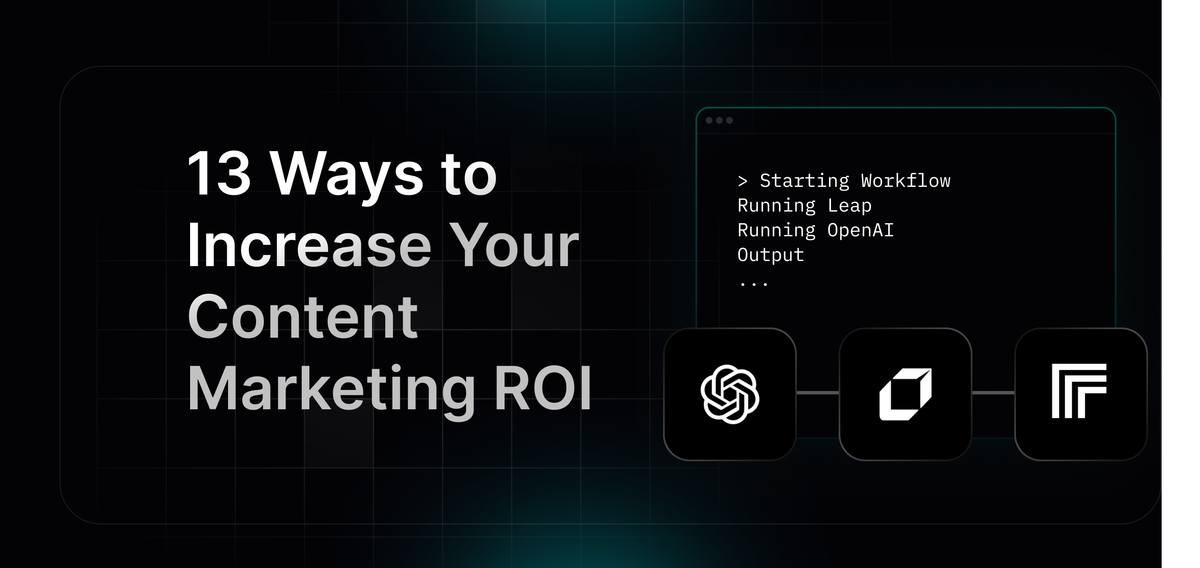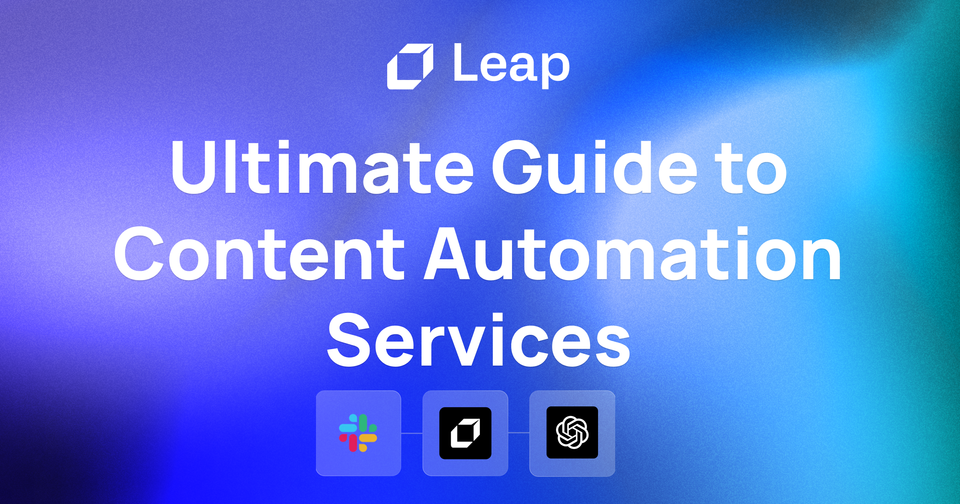13 Proven Ways to Increase Your Content Marketing ROI
Increase your content marketing ROI with these tactics! From optimizing to implementing data-driven strategies, this guide got you covered.

Are you struggling to measure the success of your content marketing efforts? Are you unsure whether your investment is translating into tangible results? Dive into the world of Content Marketing ROI, and discover how it can revolutionize your business strategy. By understanding how to calculate the ROI of your content, you can make better decisions to maximize your marketing budget. And it all starts with the right content ideation. It's time to get more bang for your buck with Content Marketing ROI.

What is Content Marketing ROI?

Content Marketing ROI, or Return on Investment, is a metric used to measure the effectiveness and success of a content marketing campaign. The primary purpose of calculating Content Marketing ROI is to determine the revenue generated from content marketing efforts compared to the total investment made in content marketing. By analyzing Content Marketing ROI, companies can gauge the profitability and effectiveness of their content marketing strategy and make informed decisions about future investments.
How to Calculate Content Marketing ROI
To calculate Content Marketing ROI, you need to analyze two key components: revenue generated from content marketing and the total investment in content marketing efforts. The formula for calculating
Content Marketing ROI is:
ROI = (Revenue generated from content marketing - Total investment in content marketing) / Investment
Total investment in content marketing
The total investment includes not only the cost of creating and distributing content but also overhead costs such as content production, distribution, and reuse. By analyzing this metric, companies can optimize their content marketing strategy, improve performance, and increase profitability.

Why Content Marketing ROI Matters

Calculating ROI is essential for any content creator. Not only does it provide an in-depth understanding of how successful your strategies are, but it also gives you a concrete financial impact of your content marketing efforts.
By calculating ROI, you can measure the revenue generated from content marketing compared to the costs incurred. This helps you to get a clear picture of how effective your strategies are and make informed decisions about future content marketing investments. It also allows you to optimize current campaigns and show the value of content marketing to stakeholders.
The Financial Impact of Content Marketing Efforts
By measuring ROI, you can understand the financial impact that content marketing has on your business. This information is crucial for making decisions about your current content marketing strategies and making adjustments when necessary.
The ability to see the effectiveness of your strategies in terms of revenue generated helps you understand if you’re investing in the right areas or if you need to make changes. This information is invaluable for making informed decisions about future content marketing investments and optimizing current campaigns.
Revenue Generated Compared to Costs Incurred
Calculating ROI involves comparing the revenue generated from content marketing to the costs incurred. This comparison provides you with valuable insights into the effectiveness of your strategies in terms of the revenue they generate. It allows you to see how much you’re spending on content marketing compared to how much revenue you’re generating and make informed decisions about future content marketing investments.
Insights into the Effectiveness of Strategies
Measuring ROI allows you to get insights into the effectiveness of your strategies. It helps you see which strategies are working and which ones aren’t. This information is invaluable for making informed decisions about future content marketing investments and optimizing current campaigns. The ability to measure the revenue generated from content marketing in comparison to the costs incurred helps you show the value of content marketing to stakeholders.
Informed Decisions About Future Content Marketing Investments
Measuring ROI provides you with the information you need to make informed decisions about future content marketing investments. It helps you understand the financial impact of your strategies and see how effective they are in terms of revenue generated. This information is essential for making decisions about your current content marketing strategies and making adjustments when necessary.
Optimizing Existing Campaigns
Calculating ROI allows you to optimize your current content marketing campaigns. By measuring the revenue generated from content marketing in comparison to the costs incurred, you can see which strategies are working and which aren’t. This information is invaluable for making informed decisions about future content marketing investments and optimizing current campaigns.
Demonstrating the Value of Content Marketing to Stakeholders
Measuring ROI helps you demonstrate the value of content marketing to stakeholders. By showing the financial impact of your content marketing efforts, you can provide stakeholders with concrete evidence of how effective your strategies are. This information is crucial for making informed decisions about future content marketing investments and optimizing current campaigns.
What are Common Challenges in Measuring Content ROI

1. Defining clear goals and metrics
In the realm of Content Marketing ROI, creating a clear and concise set of goals and metrics is the initial foundation for the success of your ROI analysis. Before you can accurately calculate the ROI of your content marketing efforts, you first need to establish what you are looking to achieve and how you are going to measure it.
2. Choosing the right tools and methods
When it comes to tracking and measuring the effectiveness of your content marketing strategy, it is essential to select the right tools and methods to assist you. Without the correct tools and methods, the data you collect may not accurately represent the impact of your content marketing efforts.
3. Accounting for external factors
External factors can greatly influence the performance of your content marketing activities and, as such, can skew or distort your ROI data. Ensuring that you monitor and adjust for these external factors is vital when calculating your content marketing ROI.
4. Communicating and aligning with stakeholders
When calculating the ROI of your content marketing, the need to communicate and align with stakeholders is vital. Different stakeholders may have differing opinions and expectations, so keeping them in the loop throughout the process is key.
5. Tracking the true cost of content production and distribution
To accurately calculate the ROI of your content marketing strategy, you must track the true cost of producing and distributing your content. This includes both the direct costs such as production fees and distribution costs, along with overhead costs associated with content production.
6. Vanity Metrics
Vanity metrics, such as website page views or social media followers, do not always accurately represent the success of your content marketing strategy. This is why it is important to be mindful of these metrics when calculating the ROI of your content marketing efforts.
Related Reading
- Content At Scale Ai Detector
- Social Media Automation
- Ai Content Creation
How To Set Effective Content Marketing Goals

Setting goals is a critical step in any content marketing strategy. The concept of SMART goals is an effective way to ensure that your content marketing goals are clear, measurable, attainable, relevant, and time-bound. SMART goals help define your objectives clearly so that everyone on your team understands what you're working towards and why.
The emphasis is on setting goals that are not vague but specific and achievable. For instance, if you want to increase the number of visitors to your blog, a SMART goal could be to increase blog traffic by a certain percentage by a specific date by publishing a specific number of posts per week.
Examples of SMART Goals for Content Marketing
Here are some examples of SMART goals for content marketing
Specific
Increasing blog traffic by publishing more high-quality posts
Measurable
Aiming for a 5% increase in traffic
Attainable
A 5% increase seems achievable based on previous growth rates
Relevant
Raising brand awareness and nurturing leads to support sales goals
Time-bound
Achieving a 2-5% increase in traffic by the end of the next month
SMART Goals Are Important
SMART goals are important because they provide clarity, enable measurement of progress, set realistic and achievable objectives, and establish a clear pathway to achieving goals. By setting SMART goals for your content marketing efforts, you can focus on metrics that really matter, understand the progress you're making, and adjust your strategy as needed to achieve your objectives.
13 Ways to Increase Your Content Marketing ROI

1. Understand Your Audience: Tailor Content to Address Specific Audience Needs
As a content marketer, one way to increase ROI is by understanding your audience. Conduct thorough audience research and create buyer personas to understand their pain points, preferences, and behavior. Tailor your content to address specific audience needs.
2. Conduct a Content Audit: Identify Gaps and Opportunities for Improvement
Another way to increase ROI is to conduct a content audit. Evaluate existing content for relevance, quality, and performance. Identify gaps and opportunities for improvement, and prioritize content updates and repurposing.
3. Focus on Quality Over Quantity: Valuable and Engaging Content Attracts the Right Audience
Invest in creating high-quality, informative content rather than churning out low-value pieces. Quality content attracts and retains the right audience, leading to higher ROI.
4. Use Data to Inform Your Strategy: Track Performance Metrics with Care
Select marketing metrics with care and leverage analytics tools to track performance. Monitor metrics such as traffic, engagement, conversions, and bounce rates. Adjust your strategy based on data insights to increase ROI.
5. Leverage Social Media: Share Content Across Relevant Platforms
To increase ROI, share content across relevant social platforms. Engage with your audience through comments, shares, and direct messages, and use social media analytics to refine your approach.
6. Experiment with Different Formats: Diversify Your Content Formats
Explore videos, infographics, podcasts, and interactive content. Different formats resonate with different audiences, so test and iterate to find what works best for your brand.
7. Incorporate User-Generated Content: Encourage Customers to Share Their Experiences
Encourage customers to share their experiences through reviews, testimonials, and photos. User-generated content builds trust and authenticity, benefiting your ROI.
8. Optimize for Search Engines: Improve On-Page SEO for Higher Organic Traffic
Conduct keyword research, optimize content for relevant terms, and improve on-page SEO elements. High-ranking content attracts organic traffic, increasing ROI.
9. Track Content Marketing ROI with Attribution Models: Measure Conversions Influenced by
ContentUse attribution models to understand content impact and measure conversions influenced by content. Assign value to each touchpoint in the customer journey to increase ROI.
10. Repurpose and Extend Content Lifespan: Maximizing Existing Content's Potential
Repurpose existing content into different formats, update evergreen content, and extend content reach through guest posts and collaborations to maximize ROI.
11. Optimize Landing Pages: Boost Conversion Rates with Well-Optimized Pages
Create dedicated landing pages for specific campaigns, optimize design, copy, and A well-optimized landing page boosts conversion rates, increasing ROI.
12. Nurture Leads with Email Marketing: Build an Email List and Segment Subscribers
Leverage email marketing to nurture leads, build an email list, segment subscribers, and send targeted content to improve ROI through better engagement.
13. Monitor and Adjust Continuously: Stay Informed About Industry Trends
Regularly review performance metrics, stay informed about industry trends, and adjust your content strategy to changing audience needs to increase ROI.
Leap helps you to automate your work with the power of AI
Partnered with Zapier, Vercel, and more, Leap enables you to supercharge your work by allowing you to create custom AI automations. Create sophisticated AI automations with no-code. Connect the tools you love with best-in-class AI text, image, and audio models.
Supercharge your existing tools with seamless AI integrations to OpenAI, Microsoft, and more. From summarizing documents, to voice translation, to AI call transcription, to AI avatar and asset generation, to SEO automation, to even automating the cold email creation and sending process, automate anything with Leap Workflows. The opportunities for automation are endless with Leap workflows.
Try Leap’s AI Workflows tool for free today.
Related Reading
- Content Scaling
- Content Automation
- Content Workflow
- Content Marketing Automation
- How To Make Ai Content Undetectable
- How To Train Chatgpt To Write Like You
- Content Marketing Workflow
- Best Instagram Automation
- Ai Powered Content Creation
- Ai Content Optimization
- Content Planning For Social Media
- Ai Content Management
- Ai And Content Marketing
- Content Production Process
- How To Automate Content Creation
- Automate Blog Posts
- Cost Effective Content Marketing
10 Important Tools for Content Marketing Operations

1. Leap AI
Leap helps you automate work with the power of AI. It enables the creation of custom AI automations with no-code, seamless AI integrations to OpenAI, Microsoft, and more, and workflows for automation.
2. Semrush
Increase online presence across all major channels using a single platform. Control tracks across many social media networks without switching platforms.
3. Canva
A pioneer in visual content creation, helping users create innovative, content-friendly, and search-engine-optimized banners.
4. KingSumo
A top lead generation platform on the internet, specializing in generating leads through viral freebies at a fraction of the cost of other marketing methods.
5. ClickFunnels
A website and sales funnel builder breaking entrepreneurs free from coding constraints.
6. Hootsuite
The leader in attracting new followers to social media platforms.
7. Google Trends
Compare phrases for search traffic, spot hot topics, and more. A must-have tool for content marketers, offered for free.
8. Grammarly
Ensures spelling and grammar precision in content, increasing trust and engagement with an audience.
9. Hemingway editor
Enhances content readability by analyzing writing and suggesting improvements, named after Ernest Hemingway for a concise writing style.
10. Copyscape
A plagiarism checker ensuring unique content in a sea of millions of pieces available online.
Related Reading
- Midjourney Alternatives
- Ai Content Creation Tools
- Best Linkedin Automation Tools
- Social Media Automation Tools
- Content Automation Tools
- Writesonic Alternative
- Copy Ai Alternatives
- Jasper Ai Alternative
- Rytr Alternatives
- Wordtune Alternatives
- Ai Content Generator Api
- Content Automation Services
- Frase Alternative
Create Game Changing Automations Today With Leap’s AI Workflows
When it comes to content marketing, measuring ROI is essential to determining the success of your efforts. ROI, or return on investment, is the value you get from the content you create compared to the resources you put into it. Calculating ROI can be a bit tricky, but it's an essential step in refining your content marketing strategy.
By understanding how much value your content generates, you can optimize your efforts to drive better results.ROI is important because it helps you understand whether your content marketing efforts are generating a return on your investment and how effective your content marketing campaigns are at generating leads and sales.
Setting Clear Goals and Objectives from the Start
The first step to measuring content marketing ROI is to set clear goals and objectives from the start. By defining what you want to achieve with your content marketing efforts, you can better measure your success and determine the ROI of your campaigns.
Setting goals also helps you know what metrics to track and what data to collect. When setting goals, make sure they are specific, measurable, achievable, relevant, and time-bound — SMART goals. This will give you a clear direction and make it easier to track your progress and measure success.
Measuring the Right Metrics for Success
To measure the ROI of your content marketing efforts, it's important to track and measure the right metrics. This will help you understand the impact of your content on your bottom line and how well it's helping you achieve your goals.
Some of the key metrics to measure include leads generated, sales, traffic, engagement, and conversions. You also want to track how well specific pieces of content are performing. By tracking these metrics, you can determine the success of your content marketing efforts and refine your strategy as needed.
Calculating Content Marketing ROI
Calculating content marketing ROI involves measuring the return on investment of your content marketing efforts. ROI is calculated by dividing the revenue generated from your content marketing efforts by the cost of producing and distributing that content.
To calculate ROI, you need to track how much you spend on creating and promoting content and how much revenue that content generates. This will give you a clear picture of how well your content marketing efforts are performing and help you make data-driven decisions to drive better results.




